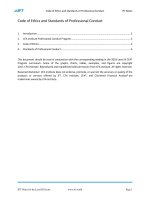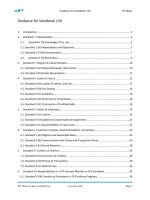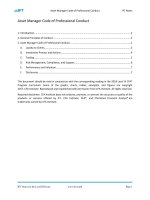CFA 2018 level 3 schweser practice exam CFA 2018 level 3 question bank CFA 2018 r30 risk management applications of swap strategies summary
Bạn đang xem bản rút gọn của tài liệu. Xem và tải ngay bản đầy đủ của tài liệu tại đây (524.52 KB, 11 trang )
Level III
Risk Management Applications of Swap
Strategies
Summary
Graphs, charts, tables, examples, and figures are copyright 2016, CFA Institute.
Reproduced and republished with permission from CFA Institute. All rights reserved.
Using an Interest Rate Swap to
Convert a Floating Rate Loan to Fixed
Rate Loan
Swaps can also be used to convert fixed rate
loans to floating rate loans.
By using swaps, cash flow risk is reduced because the uncertain future floating rate payments on loans are essentially
converted into fixed rate payments. These fixed payments can be more easily planned for, resulting in the reduction
of cash flow risk.
2
Duration of an Interest Rate Swap
Duration of a floater is equal to half the time between reset dates. If a
floater has reset dates every quarter (i.e. every 0.25 years), the duration is
approximately 0.25/2 = 0.125 years.
Duration of a 1-year bond which makes a fixed coupon payment every
quarter is approximately 0.75 years.
The duration of a one-year pay-fixed, receive-floating swap with quarterly
settlements = 0.125 – 0.75 = - 0.625.
Pay-fixed, receive-floating swaps will have a negative duration.
Pay-floating, receive-fixed swaps will have a positive duration.
3
Using Swaps to Change the Duration of a Bond Portfolio
Notional principal of swap = Portfolio value * (Target duration – Original
duration) / Swap duration
Consider a scenario where a company controls a $500 million fixed-income
portfolio that has a duration of 6.75. We want to reduce the duration to 3.50
using a five-year swap with semiannual payments.
Since we want to reduce the duration we should use a pay fixed receive
floating swap.
For a five-year pay fixed receive floating swap the duration is -5*0.75 + 0.25
= -3.50
Notional principal of swap = 500 million * (3.50 – 6.75) / (3.50)
= 464,290,000.
4
Currency Swaps
If a company needs to borrow a foreign currency, it can
generate savings by issuing a loan or bond in its own currency
and using a currency swap to convert the obligation into
another currency.
ROTEC is a British company which plans to expand in Europe and
needs euros. The options available to ROTEC are:
It could issue a euro-denominated bond, but it is not as well
known in the euro market, hence its cost of borrowing will be
higher.
It could issue a pound-denominated bond and convert it to a
euro-denominated bond using a currency swap. This will
lower its cost of borrowing.
5
Converting Foreign Cash Receipts into Domestic Currency
If a company has foreign subsidiaries then it will regularly generate cash in foreign currencies. This cash will
be repatriated back in domestic currency on a regular basis. If these cash flows are predictable in quantity,
then by using a currency swap we can lock the rate at which they are converted.
A US-based company, COLS, has a foreign
subsidiary in Japan. It converts income generated
in Japan into US dollars four times a year. To lock in
its conversion rate for the entire year, it enters into
a currency swap with a dealer USMULT. Through
this swap COLS will make fixed payments in
Japanese yen and receive fixed payments in US
dollars at a fixed exchange rate.
Risks faced by COLS:
Credit risk of the counterparty defaulting.
Risk that its operations will not generate ¥300 million.
6
Equity Swaps
Equity swaps can be used to diversify a concentrated equity portfolio, provide international diversification to a
domestic portfolio, and alter portfolio allocations to stocks and bonds.
Diversification of a concentrated position
International diversification
CWF has received a large donation of ZYKT stock. To
achieve diversification, without selling the stock, it
enters into an equity swap with a dealer.
USRM has $500 million invested in US stocks. The
organization wants to invest 10% of its portfolio
internationally.
7
A combination of equity swaps and fixed income swaps can be used to change asset allocation.
Stock
Large cap
Mid cap
Small cap
Bonds
Government
Corporate
Current
$150 Million, (75%)
$90 million (60%)
$45 million (30%)
$15 million (10%)
Current
$50 Million, (25%)
$40 million (80%)
$10 million (20%)
New
$180 Million, (90%)
$117 million (65%)
$45 million (25%)
$18 million (10%)
New
$20 Million, (10%)
$15 million (75%)
$5 million (25%)
Transaction
Buy $27 million
None
Buy $3 million
Transaction
Sell $25 million
Sell $5 million
Equity swaps
Receive return on S&P500 on $27 million; Pay Libor on $27 million
Receive return on SPSC on $3 million; Pay Libor on $3 million
Fixed-income swaps
Receive Libor on $25 million; Pay return on LLTB on $25 million
Receive Libor on $5 million; Pay return on MLCB on $5 million
By eliminating LIBOR and by combining the
equity and fixed income swaps, we get a single
swap with the following payments:
Receive return on SP500 on $27 million
Receive return on SPSC on $3 million
Pay return on LLTB on $25 million
Pay return on MLCB on $5 million
8
Swaptions
A swaption is an option to enter into a swap. It is like an interest rate option because it has an exercise rate. For
example: You have an option to enter into a three-year swap with semi-annual payments with an exercise rate of 7%.
There are two types of swaptions:
1. A payer swaption allows the holder to enter a swap as a fixed rate payer.
2. A receiver swaption allows the holder to enter a swap as a fixed rate receiver.
9
Using a swaption to change the payment
pattern of a future loan
Consider a scenario where a company anticipates
that it will take out a loan at a future date. The
company expects that the bank will require it to be a
floating rate loan. To eliminate interest rate risk it will
use a swap to convert this loan into a fixed rate loan.
If the company wants to enter into the swap at an
attractive rate, it can use a swaption.
Exhibit 12 illustrates this scenario. Company BCHEM
wants to borrow in the future at a floating rate from
bank ANB. It wants to enter into a swap to pay fixed
rate if the rates are attractive. To do so it buys a
swaption from dealer DTD.
10
Using a swaption to terminate a swap
IMS takes out a $20 million ten-year loan with
quarterly floating payments at Libor from a lender
called Financial Solutions (FINSOLS). Fearing an
increase in interest rates, IMS engages in a pay-fixed,
receive-floating swap that converts the loan into a
fixed-rate loan at 8 percent.
IMS believes, however, that the interest rate outlook
could change, and it would like the flexibility to
terminate the swap, thereby returning to the status of
a floating-rate payer. To give it this flexibility, IMS
purchases an American-style receiver swaption for
$515,000. The swaption allows it to enter into a
receive-fixed, pay-floating swap at a fixed rate of 8
percent at the swaption expiration.
11









